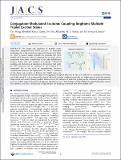Files in this item
Conjugation-modulated excitonic coupling brightens multiple triplet excited states
Item metadata
| dc.contributor.author | Wang, Tao | |
| dc.contributor.author | Gupta, Abhishek Kumar | |
| dc.contributor.author | Wu, Sen | |
| dc.contributor.author | Slawin, Alexandra Martha Zoya | |
| dc.contributor.author | Zysman-Colman, Eli | |
| dc.date.accessioned | 2023-01-16T11:06:03Z | |
| dc.date.available | 2023-01-16T11:06:03Z | |
| dc.date.issued | 2023-01-25 | |
| dc.identifier | 282599515 | |
| dc.identifier | fda9f102-e3c9-4b92-a8bb-a56e7a6a325c | |
| dc.identifier | 000920321900001 | |
| dc.identifier | 85146309024 | |
| dc.identifier.citation | Wang , T , Gupta , A K , Wu , S , Slawin , A M Z & Zysman-Colman , E 2023 , ' Conjugation-modulated excitonic coupling brightens multiple triplet excited states ' , Journal of the American Chemical Society , vol. 145 , no. 3 , pp. 1945-1954 . https://doi.org/10.1021/jacs.2c12320 | en |
| dc.identifier.issn | 0002-7863 | |
| dc.identifier.other | ORCID: /0000-0002-9527-6418/work/127065970 | |
| dc.identifier.other | ORCID: /0000-0001-7183-6022/work/127066428 | |
| dc.identifier.uri | https://hdl.handle.net/10023/26757 | |
| dc.description | Funding: This project has received funding from the European Union’s Horizon 2020 research and innovation programme under the Marie Skłodowska Curie grant agreement no. 897098 (AIE-RTP-PLED). T.W. acknowledges support from the Marie Skłodowska-Curie Individual Fellowship. S.W. thanks the China Scholarship Council (201906250199). We thank the EPSRC (EP/R035164/1) for financial support. | en |
| dc.description.abstract | The design and regulation of multiple room-temperature phosphorescence (RTP) processes are formidably challenging due to the restrictions imposed by Kasha’s rule. Here, we report a general design principle for materials that show multiple RTP processes, which is informed by our study of four compounds where there is modulation of the linker hybridization between donor (D) and acceptor (A) groups. Theoretical modeling and photophysical experiments demonstrate that multiple RTP processes can be achieved in sp3 C-linked D–A compounds due to the arrest of intramolecular electronic communication between two triplet states (T1H and T1L) localized on the donor and acceptor or between two triplet states, one localized on the donor and one delocalized across aggregated acceptors. However, for the sp2 C-linked D–A counterparts, RTP from one locally excited T1 state is observed because of enhanced excitonic coupling between the two triplet states of molecular subunits. Single-crystal and reduced density gradient analyses reveal the influence of molecular packing on the coincident phosphorescence processes and the origin of the observed aggregate phosphorescence. These findings provide insights into higher-lying triplet excited-state dynamics and into a fundamental design principle for designing compounds that show multiple RTP. | |
| dc.format.extent | 10 | |
| dc.format.extent | 7168594 | |
| dc.language.iso | eng | |
| dc.relation.ispartof | Journal of the American Chemical Society | en |
| dc.subject | QD Chemistry | en |
| dc.subject | DAS | en |
| dc.subject | MCC | en |
| dc.subject.lcc | QD | en |
| dc.title | Conjugation-modulated excitonic coupling brightens multiple triplet excited states | en |
| dc.type | Journal article | en |
| dc.contributor.sponsor | EPSRC | en |
| dc.contributor.institution | University of St Andrews. Centre for Energy Ethics | en |
| dc.contributor.institution | University of St Andrews. EaSTCHEM | en |
| dc.contributor.institution | University of St Andrews. School of Chemistry | en |
| dc.contributor.institution | University of St Andrews. Institute of Behavioural and Neural Sciences | en |
| dc.identifier.doi | 10.1021/jacs.2c12320 | |
| dc.description.status | Peer reviewed | en |
| dc.identifier.grantnumber | EP/R035164/1 | en |
This item appears in the following Collection(s)
Items in the St Andrews Research Repository are protected by copyright, with all rights reserved, unless otherwise indicated.

